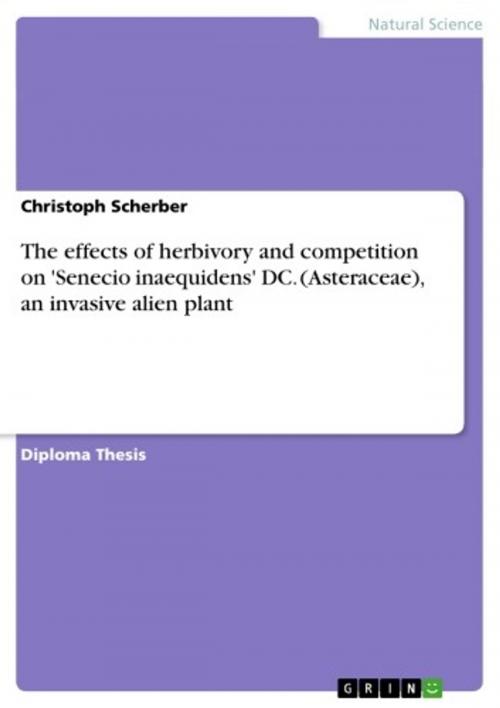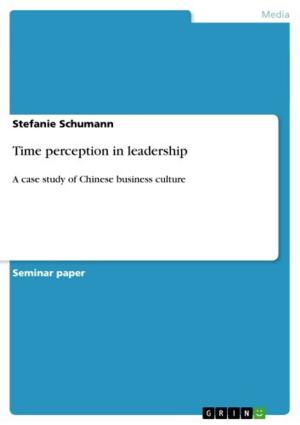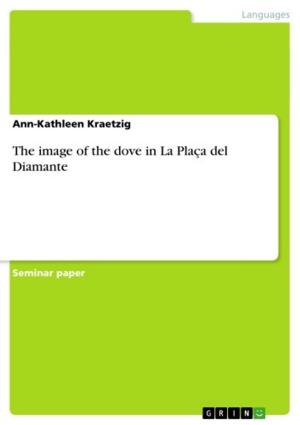The effects of herbivory and competition on 'Senecio inaequidens' DC. (Asteraceae), an invasive alien plant
Nonfiction, Science & Nature, Science, Biological Sciences, Ecology| Author: | Christoph Scherber | ISBN: | 9783638158039 |
| Publisher: | GRIN Publishing | Publication: | December 7, 2002 |
| Imprint: | GRIN Publishing | Language: | English |
| Author: | Christoph Scherber |
| ISBN: | 9783638158039 |
| Publisher: | GRIN Publishing |
| Publication: | December 7, 2002 |
| Imprint: | GRIN Publishing |
| Language: | English |
Diploma Thesis from the year 2002 in the subject Biology - Ecology, grade: 1,0 (A), University of Rostock (Institute for Botany), 120 entries in the bibliography, language: English, abstract: Since the end of the 19th century, overall per-capita mobility of humans has increased significantly, leading to increased rates in human-mediated transportation of animal and plant species. The rapid spread of alien organisms, however, may lead to quick and unpredictable changes in ecosystems. Senecio inaequidens DC. (Asteraceae) is an invasive alien plant from South Africa that was first introduced to Europe 100 years ago and is characterized by an exceptionally fast rate of spread; it contains pyrrolizidine alkaloids that are toxic to invertebrates, livestock and humans. In the study presented here, laboratory, greenhouse and field experiments on the biology of Senecio inaequidens were conducted, in order to find out if and how herbivory and plant competition influence growth, survival and reproduction of this plant. Specifically, the presence of vertebrate herbivores, molluscs, insects and plant competitors was experimentally manipulated using full factorial and split-plot designs. All experiments were performed at Imperial College, Silwood Park, about 30 km west of London (UK). Growth and fecundity of Senecio inaequidens were significantly affected by interspecific competition. Vertebrate herbivory only had a significant effect when a closed vegetation cover was present. On artificially disturbed plots, Senecio inaequidens showed high capability to overcompensate for herbivory. Mollusc herbivory significantly reduced fecundity of S. inaequidens. Different ecotypes of Senecio inaequidens showed different amounts of herbivore damage. One of the most remarkable results of this study was that Longitarsus jacobaeae, a native specialist leaf beetle, freely colonized Senecio inaequidens, indicating that native herbivores might be suitable biocontrol agents of invasive alien plants in the future. Host switching from indigenous to invasive alien plant species in oligophagous insect herbivores may be more common than generally thought. The results of this study indicate that Senecio inaequidens is likely to invade and persist in heavily grazed or disturbed grassland ecosystems in the near future; because of the toxic compounds this plant contains, it would be advisable to design a preventive management program and to inform the public about the consequences that might be associated with the invasion of this plant.
Diploma Thesis from the year 2002 in the subject Biology - Ecology, grade: 1,0 (A), University of Rostock (Institute for Botany), 120 entries in the bibliography, language: English, abstract: Since the end of the 19th century, overall per-capita mobility of humans has increased significantly, leading to increased rates in human-mediated transportation of animal and plant species. The rapid spread of alien organisms, however, may lead to quick and unpredictable changes in ecosystems. Senecio inaequidens DC. (Asteraceae) is an invasive alien plant from South Africa that was first introduced to Europe 100 years ago and is characterized by an exceptionally fast rate of spread; it contains pyrrolizidine alkaloids that are toxic to invertebrates, livestock and humans. In the study presented here, laboratory, greenhouse and field experiments on the biology of Senecio inaequidens were conducted, in order to find out if and how herbivory and plant competition influence growth, survival and reproduction of this plant. Specifically, the presence of vertebrate herbivores, molluscs, insects and plant competitors was experimentally manipulated using full factorial and split-plot designs. All experiments were performed at Imperial College, Silwood Park, about 30 km west of London (UK). Growth and fecundity of Senecio inaequidens were significantly affected by interspecific competition. Vertebrate herbivory only had a significant effect when a closed vegetation cover was present. On artificially disturbed plots, Senecio inaequidens showed high capability to overcompensate for herbivory. Mollusc herbivory significantly reduced fecundity of S. inaequidens. Different ecotypes of Senecio inaequidens showed different amounts of herbivore damage. One of the most remarkable results of this study was that Longitarsus jacobaeae, a native specialist leaf beetle, freely colonized Senecio inaequidens, indicating that native herbivores might be suitable biocontrol agents of invasive alien plants in the future. Host switching from indigenous to invasive alien plant species in oligophagous insect herbivores may be more common than generally thought. The results of this study indicate that Senecio inaequidens is likely to invade and persist in heavily grazed or disturbed grassland ecosystems in the near future; because of the toxic compounds this plant contains, it would be advisable to design a preventive management program and to inform the public about the consequences that might be associated with the invasion of this plant.















